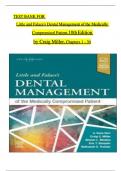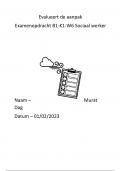TEST BANK FOR
Little and Falace's Dental Management of the Medically
Compromised Patient,10th Edition
by Craig Miller, Chapters 1 - 30
,Little: Dental Management of the Medically Compromised Patient, 10th Edition Test Bank
Table of Contents
PART ONE: PATIENT EVALUATION AND RISK ASSESSMENT
Chapter 1: Patient Evaluation and Risk Assessment
PART TWO: CARDIOVASCULAR DISEASE
Chapter 2: Infective Endocarditis
Chapter 3: Hypertension
Chapter 4: Ischemic Heart Disease
Chapter 5: Cardiac Arrhythmias
Chapter 6: Heart Failure (or Congestive Heart Failure)
PART THREE: PULMONARY DISEASE
Chapter 7: Pulmonary Disease
Chapter 8: Smoking and Tobacco Use Cessation
Chapter 9: Sleep-Related Breathing Disorders
PART FOUR: GASTROINTESTIAL DISEASE
Chapter 10: Liver Disease
Chapter 11: Gastrointestinal Disease
PART FIVE: GENITOURINARY DISEASE
Chapter 12: Chronic Kidney Disease and Dialysis
Chapter 13: Sexually Transmitted Diseases
PART SIX: ENDOCRINE AND METABOLIC DISEASE
Chapter 14: Diabetes Mellitus
Chapter 15: Adrenal Insufficiency
Chapter 16: Thyroid Diseases
Chapter 17: Pregnancy and Breast Feeding
PART SEVEN: IMMUNOLOGIC DISEASE
Chapter 18: AIDS, HIV Infection, and Related Conditions
Chapter 19: Allergy
Chapter 20: Rheumatologic and Connective Tissue Disorders
Chapter 21: Organ and Bone Marrow Transplantation
PART EIGHT: HEMATOLOGIC AND ONCOLOGIC DISEASE
Chapter 22: Disorders of Red Blood Cells
Chapter 23: Disorders of White Blood Cells
Chapter 24: Acquired Bleeding and Hypercoagulable Disorders
Chapter 25: Congenital Bleeding and Hypercoagulable Disorders
Chapter 26: Cancer and Oral Care of the Patient
PART NINE: NEUROLOGIC, BEHAVIORAL, AND PSYCHIATRIC DISORDERS
Chapter 27: Neurologic Disorders
Chapter 28: Anxiety, Eating Disorders, and Behavioral Reactions to Illness
Chapter 29: Psychiatric Disorders
Chapter 30: Drug and Alcohol Abuse
, WWW.GRADESMORE.COM
Stuvia.com - The Marketplace to Buy and Sell your Study Material
Page 1 of 74
Chapter 01: Patient Evaluation and Risk Assessment
Little: Dental Management of the Medically Compromised Patient, 10th Edition
MULTIPLE CHOICE
1. Elective dental care should be deferred for patients with severe, uncontrolled hypertension,
meaning that the blood pressure is greater than or equal to mm Hg.
a. 200/140
b. 180/140
c. 180/110
d. 160/110
ANSWER: C
Elective dental care should be deferred for patients with severe, uncontrolled hypertension,
which is blood pressure greater than or equal to 180/110 mm Hg, until the condition can be
brought under control.
2. The American Heart Association currently recommends antibiotic prophylaxis for a patient
with which of the following cardiac conditions?
a. Mitral valve prolapse
b. Prosthetic heart valve
c. Rheumatic heart disease
d. Pacemakers for cardiac arrhythmias
ANSWER: B
Previously, the American Heart Association (AHA) recommended antibiotic prophylaxis for
many patients with heart murmurs caused by valvular disease (e.g., mitral valve prolapse,
rheumatic heart disease) in an effort to prevent infective endocarditis; however, current
guidelines omit this recommendation on the basis of accumulated scientific evidence. If a
murmur is due to certain specific cardiac conditions (e.g., previous endocarditis, prosthetic
heart valve, complex congenital cyanotic heart disease), the AHA continues to recommend
antibiotic prophylaxis for most dental procedures.
3. One consequence of chronic hepatitis (B or C) or cirrhosis of the liver is decreased ability of
the body to certain drugs, including local anesthetics and analgesics.
a. absorb
WWW.NURSYLAB.COM
GRADESMORE.COM
, WWW.GRADESMORE.COM
Stuvia.com - The Marketplace to Buy and Sell your Study Material
Page 1 of 74
b. distribute
c. metabolize
d. excrete
ANSWER: C
Patients also may have chronic hepatitis (B or C) or cirrhosis, with impairment of liver
function. This deficit may result in prolonged bleeding and less efficient metabolism of
certain drugs, including local anesthetics and analgesics.
4. Which of the following symptoms and signs is most consistent with allergy?
a. Heart palpitations
b. Itching
c. Vomiting
d. Fainting
WWW.NURSYLAB.COM
GRADESMORE.COM
, WWW.GRADESMORE.COM
Stuvia.com - The Marketplace to Buy and Sell your Study Material
Page 1 of 74
ANSWER: B
Symptoms and signs consistent with allergy include itching, urticaria (hives), rash, swelling,
wheezing, angioedema, runny nose, and tearing eyes. Isolated signs and symptoms such as
nausea, vomiting, heart palpitations, and fainting generally are not of an allergic origin but
rather are manifestations of drug intolerance, adverse side effects, or psychogenic reactions.
5. Which of the following is true of the patient with a history of tuberculosis?
a. A positive result on skin testing means that the person has active TB.
b. Most patients who become positive skin testers develop active disease.
c. Patients with acquired immunodeficiency syndrome (AIDS) have a high incidence
of tuberculosis.
d. A diagnosis of active TB is made by a purified protein derivative (PPD) skin test.
ANSWER: C
The potential coexistence of tuberculosis and acquired immunodeficiency syndrome (AIDS)
should be explored because patients with AIDS have a high incidence of tuberculosis. A
positive result on skin testing means specifically that the person has at some time been
infected with TB, not necessarily that active disease is present. Most patients who become
positive skin testers do not develop active disease. A diagnosis of active TB is made by chest
x-ray, imaging, sputum culture, and clinical examination.
6. Vasoconstrictors should be avoided in patients who cocaine or methamphetamine users
because these agents may precipitate .
a. severe hypotension
b. severe hypertension
c. respiratory depression
d. cessation of intestinal peristalsis
ANSWER: B
Vasoconstrictors should be avoided in patients who are cocaine or methamphetamine users
because the combination may precipitate arrhythmias, MI, or severe hypertension.
7. It has been shown that the risk for occurrence of a serious perioperative cardiovascular event
(e.g., MI, heart failure) is increased in patients who are unable to meet a -MET (metabolic
equivalent of task) demand during normal daily activity.
a. 4
WWW.NURSYLAB.COM
GRADESMORE.COM
, WWW.GRADESMORE.COM
Stuvia.com - The Marketplace to Buy and Sell your Study Material
Page 1 of 74
b. 6
c. 8
d. 10
ANSWER: A
Daily activities requiring 4 METs include level walking at 4 miles/hour or climbing a flight of
stairs. Activities requiring greater than 10 METs include swimming and singles tennis. An
exercise capacity of 10 to 13 METs indicates excellent physical conditioning.
8. Which of the following alterations in the fingernails is associated with cirrhosis?
a. Yellowing
b. Clubbing
c. White discoloration
d. Splinter hemorrhages
WWW.NURSYLAB.COM
GRADESMORE.COM
, WWW.GRADESMORE.COM
Stuvia.com - The Marketplace to Buy and Sell your Study Material
Page 1 of 74
ANSWER: C
Alterations in the fingernails, such as clubbing (seen in cardiopulmonary insufficiency), white
discoloration (seen in cirrhosis), yellowing (from malignancy), and splinter hemorrhages
(from infective endocarditis) usually are caused by chronic disorders.
9. A blood pressure cuff should be placed on the upper arm and inflated until .
a. the radial pulse disappears
b. the radial pulse disappears and then inflated an additional 20 to 30 mm Hg
c. two fingers cannot fit comfortably under the cuff
d. the pulse no longer can be heard with the stethoscope
ANSWER: B
While the radial pulse is palpated, the cuff is inflated until the radial pulse disappears
(approximate systolic pressure); it is then inflated an additional 20 to 30 mm Hg.
10. Which of the following is true of a patient classified ASA III according to the American
Society of Anesthesiologists (ASA) Physical Status Classification System?
a. Patient has mild systemic disease.
b. Patient’s disease has significant impact on daily activity.
c. Patient’s disease is unlikely to have impact on anesthesia and surgery.
d. Patient is moribund.
ANSWER: B
Patient with severe systemic disease is a constant threat to life (e.g., recent myocardial
infarction, stroke, transient ischemic attach [<3 months], ongoing cardiac ischemia, severe
valve dysfunction, respiratory failure requiring mechanical ventilation). Serious limitation of
daily activity; likely major impact on anesthesia and surgery.
WWW.NURSYLAB.COM
GRADESMORE.COM
, WWW.GRADESMORE.COM
Stuvia.com - The Marketplace to Buy and Sell your Study Material
Page 1 of 74
Chapter 02: Infective Endocarditis
Little: Dental Management of the Medically Compromised Patient, 10th Edition
MULTIPLE CHOICE
1. Which of the following is true concerning infective endocarditis (IE)?
a. IE is always due to a bacterial infection.
b. Since the advent of antibiotics, morbidity and mortality associated with IE have
been virtually eliminated.
c. IE is currently classified as acute or subacute, to reflect the rapidity of onset and
duration.
d. Accumulating evidence questions the validity of antibiotic prophylaxis in an
attempt to prevent IE prior to certain invasive dental procedures.
ANSWER: D
Antibiotics have been administered before certain invasive dental procedures in an attempt to
prevent infection. Of note, however, the effectiveness of such prophylaxis in humans has
never been substantiated, and accumulating evidence more and more questions the validity of
this practice.
2. Which of the following is currently the most common underlying condition predisposing to
infective endocarditis (IE)?
a. Aortic valve disease
b. Rheumatic heart disease (RHD)
c. Mitral valve prolapse (MVP)
d. Tetralogy of Fallot
ANSWER: C
Mitral valve prolapse, which accounts for 25% to 30% of adult cases of native valve
endocarditis (NVE), is now the most common underlying condition among patients who
acquire IE. Previously, rheumatic heart disease (RHD) was the most common condition
predisposing to endocarditis. In developed countries, however, the frequency of RHD has
markedly declined over the past several decades.
3. The leading cause of death due to infective endocarditis (IE) is .
a. chronic obstructive pulmonary disease
WWW.NURSYLAB.COM
GRADESMORE.COM
, WWW.GRADESMORE.COM
Stuvia.com - The Marketplace to Buy and Sell your Study Material
Page 1 of 74
b. heart failure
c. pulmonary emboli
d. atheromas
ANSWER: B
The most common complication of IE, and the leading cause of death, is heart failure, which
results from severe valvular dysfunction. This pathologic process most commonly begins as a
problem with aortic valve involvement, followed by mitral and then tricuspid valve infection.
Embolization of vegetation fragments often leads to further complications, such as stroke.
Myocardial infarction can occur as the result of embolism of the coronary arteries, and distal
emboli can produce peripheral metastatic abscesses.
WWW.NURSYLAB.COM
GRADESMORE.COM





